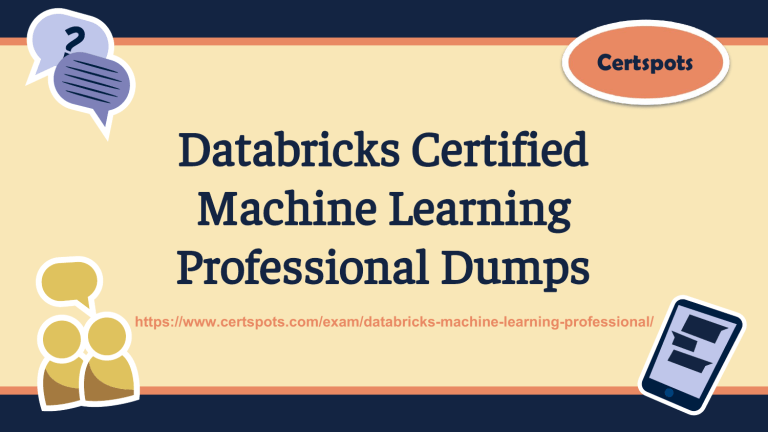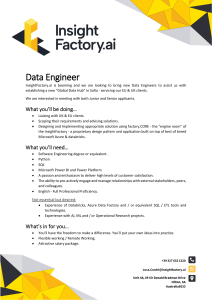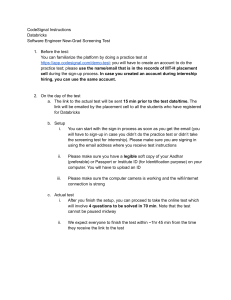
Certspots Databricks Certified Machine Learning Professional Dumps https://www.certspots.com/exam/databricks-machine-learning-professional/ Databricks Machine Learning Professional Dumps 1. Which of the following MLflow Model Registry use cases requires the use of an HTTP Webhook? A.Starting a testing job when a new model is registered B.Updating data in a source table for a Databricks SQL dashboard when a model version transitions to the Production stage C.Sending an email alert when an automated testing Job fails D.None of these use cases require the use of an HTTP Webhook E.Sending a message to a Slack channel when a model version transitions stages Answer: B Databricks Machine Learning Professional Dumps 2. Which of the following lists all of the model stages are available in the MLflow Model Registry? A.Development. Staging. Production B.None. Staging. Production C.Staging. Production. Archived D.None. Staging. Production. Archived E.Development. Staging. Production. Archived Answer: A Databricks Machine Learning Professional Dumps 3. A machine learning engineer needs to deliver predictions of a machine learning model in real-time. However, the feature values needed for computing the predictions are available one week before the query time. Which of the following is a benefit of using a batch serving deployment in this scenario rather than a real-time serving deployment where predictions are computed at query time? A.Batch serving has built-in capabilities in Databricks Machine Learning B.There is no advantage to using batch serving deployments over real-time serving deployments C.Computing predictions in real-time provides more up-to-date results D.Testing is not possible in real-time serving deployments E.Querying stored predictions can be faster than computing predictions in real-time Answer: A Databricks Machine Learning Professional Dumps 4. Which of the following describes the purpose of the context parameter in the predict method of Python models for MLflow? A.The context parameter allows the user to specify which version of the registered MLflow Model should be used based on the given application's current scenario B.The context parameter allows the user to document the performance of a model after it has been deployed C.The context parameter allows the user to include relevant details of the business case to allow downstream users to understand the purpose of the model D.The context parameter allows the user to provide the model with completely custom ifelse logic for the given application's current scenario E.The context parameter allows the user to provide the model access to objects like preprocessing models or custom configuration files Answer: A Databricks Machine Learning Professional Dumps 5. A machine learning engineering team has written predictions computed in a batch job to a Delta table for querying. However, the team has noticed that the querying is running slowly. The team has already tuned the size of the data files. Upon investigating, the team has concluded that the rows meeting the query condition are sparsely located throughout each of the data files. Based on the scenario, which of the following optimization techniques could speed up the query by colocating similar records while considering values in multiple columns? A.Z-Ordering B.Bin-packing C.Write as a Parquet file D.Data skipping E.Tuning the file size Answer: E Databricks Machine Learning Professional Dumps 6. Which of the following Databricks-managed MLflow capabilities is a centralized model store? A.Models B.Model Registry C.Model Serving D.Feature Store E.Experiments Answer: C Databricks Machine Learning Professional Dumps 7. A machine learning engineer wants to log and deploy a model as an MLflow pyfunc model. They have custom preprocessing that needs to be completed on feature variables prior to fitting the model or computing predictions using that model. They decide to wrap this preprocessing in a custom model class ModelWithPreprocess, where the preprocessing is performed when calling fit and when calling predict. They then log the fitted model of the ModelWithPreprocess class as a pyfunc model. Which of the following is a benefit of this approach when loading the logged pyfunc model for downstream deployment? A.The pvfunc model can be used to deploy models in a parallelizable fashion B.The same preprocessing logic will automatically be applied when calling fit C.The same preprocessing logic will automatically be applied when calling predict D.This approach has no impact when loading the logged Pvfunc model for downstream deployment E.There is no longer a need for pipeline-like machine learning objects Answer: E Databricks Machine Learning Professional Dumps 8. Which of the following describes label drift? A. Label drift is when there is a change in the distribution of the predicted target given by the model B. None of these describe label drift C. Label drift is when there is a change in the distribution of an input variable D. Label drift is when there is a change in the relationship between input variables and target variables E. Label drift is when there is a change in the distribution of a target variable Answer: C Databricks Machine Learning Professional Dumps 9. Which of the following is a simple statistic to monitor for categorical feature drift? A. Mode B. None of these C. Mode, number of unique values, and percentage of missing values D. Percentage of missing values E. Number of unique values Answer: C Databricks Machine Learning Professional Dumps 10. Which of the following is a probable response to identifying drift in a machine learning application? A. None of these responses B. Retraining and deploying a model on more recent data C. All of these responses D. Rebuilding the machine learning application with a new label variable E. Sunsetting the machine learning application Answer: A


